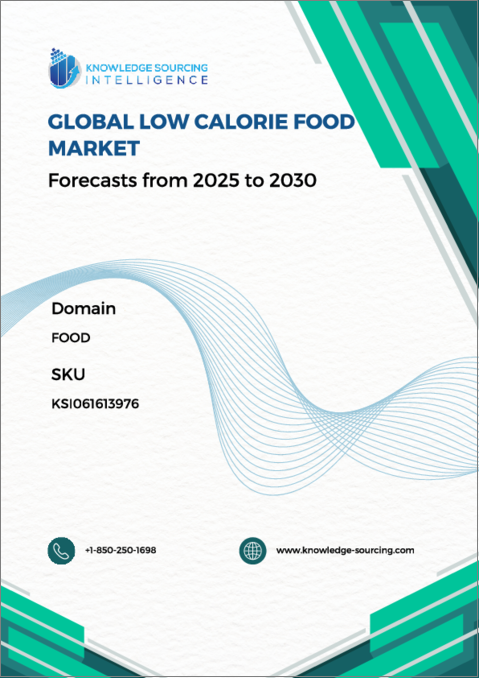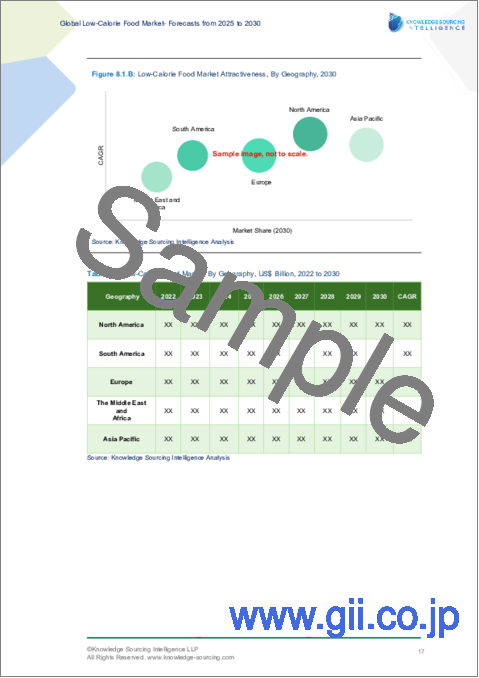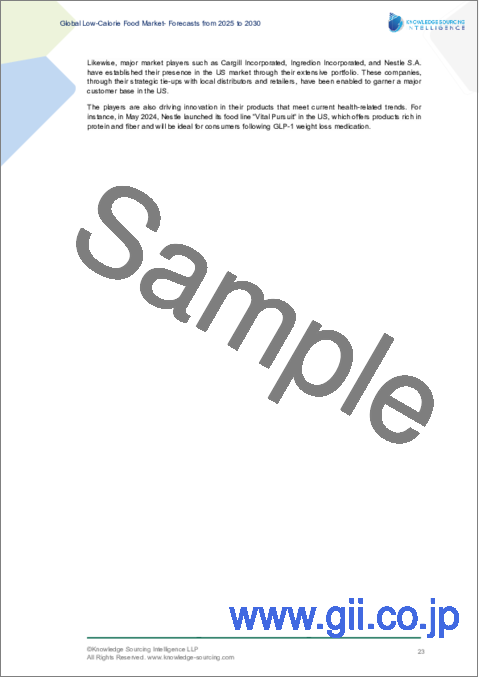|
|
市場調査レポート
商品コード
1627673
低カロリー食品の世界市場:予測(2025年~2030年)Global Low Calories Food Market - Forecasts from 2025 to 2030 |
||||||
カスタマイズ可能
|
|||||||
| 低カロリー食品の世界市場:予測(2025年~2030年) |
|
出版日: 2024年12月12日
発行: Knowledge Sourcing Intelligence
ページ情報: 英文 162 Pages
納期: 即日から翌営業日
|
- 全表示
- 概要
- 目次
世界の低カロリー食品市場はCAGR 6.28%で成長し、市場規模は2025年の141億5,700万米ドルから2030年には191億9,800万米ドルに達すると予想されます。
低カロリー食品市場は、健康への関心の高まりとライフスタイルの変化により、健康食品業界で急成長しています。低カロリー食品はさまざまな健康問題の解決に役立つため、こうした製品の消費拡大につながります。食間の間食とは、包装されたスナック菓子のような加工品など、少量の食品を消費することを指します。スナック食品は、タンパク質、ビタミン、ミネラル、その他の栄養成分を含む製品です。ベーグル、パンケーキ、クッキーなどの焼き菓子や、キャンディー、チョコレート、レーズンなどの甘いお菓子など、低カロリーのスナック菓子は、従来のスナック菓子とは異なり、健康的でグルテンフリーの原材料を使用しています。
さらに、健康的な生活のあらゆる側面を包括する総合的な幸福感の高まりから、食生活を意識する消費者が増えています。肥満、体重増加、栄養不良の増加など、従来のスナック菓子の悪影響が指摘される中、低カロリー食品の消費を重視し、より気を配った食習慣を採用する人が増えています。低カロリー・スナック業界の成長は、こうした食品に対する需要の増加、消費者の消費力の上昇(特に新興経済圏)、および外出先での間食傾向の高まりが原動力となっています。
低カロリー食品の世界市場の促進要因
- 健康意識の高まりが世界の低カロリー食品市場の成長に寄与しています。
適切な食生活の必要性に対する意識は年々高まっており、慢性疾患がこの意識の高まりを後押ししています。人々の食生活や日課は劇的に変化し、健康を維持したり健康問題に対処したりするために特定の食事療法を採用するよう促しています。この開発における顕著な進歩のひとつが、低カロリー・スナック製品の導入です。これらのスナックは有害な化学物質を含まず、消費カロリーは健康的な体重維持に必要な量の半分以下です。
しかし、これらの製品の製造に遺伝子組み換え作物を使用することは、臓器不全や免疫・胃腸系の障害、未熟児や不妊症などの問題を含む有害な副作用と関連しています。低カロリーのオーガニックスナックという新たな利点は、フィットネスや健康に対する消費者の意識の高まりと相まって、スナック製品業界の需要拡大を牽引しています。その結果、この需要が低カロリー・スナック市場の成長を生み出しています。
世界の低カロリー食品市場の地理的展望:
- 北米は予測期間中に急激な成長を遂げます。
北米は他のどの地域よりもファストフードやクイックサービス・レストランが多いです。低カロリーのような健康的で良質な食品やスナックへの支出が増加しているのは、一人当たり所得が高く、より健康的な食事へと進化している動向の結果です。さらに、スナック菓子のような製品の利便性に関連した消費の増加や、フィットネスや健康への関心の高まりも背景にあります。また、北米は小売業のインフラが非常に近代化されており、消費者が食料品や食品などほとんどのものに簡単にアクセスできるようになっています。低カロリーのスナック菓子など、手軽に入手できるため販売量が多いものもあります。
本レポートを購入する理由
- 洞察に満ちた分析:顧客セグメント、政府政策と社会経済要因、消費者の嗜好、産業別、その他のサブセグメントに焦点を当て、主要地域および新興地域を網羅した詳細な市場考察を得ることができます。
- 競合情勢:世界の主要企業が採用している戦略的戦略を理解し、適切な戦略による市場浸透の可能性を理解することができます。
- 市場動向と促進要因:ダイナミックな要因と極めて重要な市場動向、そしてそれらが今後の市場展開をどのように形成していくかを探っています。
- 実行可能な提言:ダイナミックな環境の中で、新たなビジネスストリームと収益を発掘するための戦略的意思決定に洞察を活用します。
- 幅広い利用者に対応:新興企業、研究機関、コンサルタント、中小企業、大企業にとって有益で費用対効果が高くなります。
企業はどのような目的で当社のレポートを使用していますか?
業界および市場考察、事業機会評価、製品需要予測、市場参入戦略、地理的拡大、設備投資の決定、規制の枠組みと影響、新製品開発、競合の影響
調査範囲
- 2022年から2030年までの過去データと予測
- 成長機会、課題、サプライチェーン展望、規制枠組み、顧客行動、動向分析
- 競合の市況、戦略、市場シェア分析
- 各国を含むセグメントと地域の収益成長と予測評価
- 企業プロファイル(戦略、製品、財務情報、主な開発など)
目次
第1章 イントロダクション
- 市場概要
- 市場の定義
- 調査範囲
- 市場セグメンテーション
- 通貨
- 前提条件
- 基準年と予測年のタイムライン
- ステークホルダーにとっての主なメリット
第2章 調査手法
- 調査デザイン
- 調査プロセス
第3章 エグゼクティブサマリー
- 主な調査結果
- CXOの視点
第4章 市場力学
- 市場促進要因
- 市場抑制要因
- ポーターのファイブフォース分析
- 業界バリューチェーン分析
- アナリストビュー
第5章 世界の低カロリー食品市場:タイプ別
- イントロダクション
- 砂糖代替品
- ステビア
- サッカリン
- アスパルテーム
- その他
- 糖アルコール代替品
- エリスリトール
- ソルビトール
- その他
- 栄養素ベースの代替品
- 脂肪ベース
- タンパク質ベース
- 炭水化物ベース
第6章 世界の低カロリー食品市場:用途別
- イントロダクション
- ベーカリー製品
- スナック
- 乳製品
- ダイエット飲料
- その他
第7章 世界の低カロリー食品市場:流通チャネル別
- イントロダクション
- オフライン
- スーパーマーケット
- コンビニエンスストア
- その他
- オンライン
第8章 世界の低カロリー食品市場:地域別
- イントロダクション
- 北米
- タイプ別
- 用途別
- 流通チャネル別
- 国別
- 南米
- タイプ別
- 用途別
- 流通チャネル別
- 国別
- 欧州
- タイプ別
- 用途別
- 流通チャネル別
- 国別
- 中東・アフリカ
- タイプ別
- 用途別
- 流通チャネル別
- 国別
- アジア太平洋地域
- タイプ別
- 用途別
- 流通チャネル別
- 国別
第9章 競合環境と分析
- 主要企業と戦略分析
- 市場シェア分析
- 合併、買収、合意およびコラボレーション
- 競合ダッシュボード
第10章 企業プロファイル
- Cargill, Incorporated
- Zydus Wellness Ltd
- Bernard Food Industries
- Ajinomoto Co., Inc.
- Beneo Group
- Ingredion Incorporated
- Galam Ltd.
- Groupe Danone.
- Nestle S.A.
- Food Darzee
- General Mills
- Unilever
- Kraft Heinz
- Herbalife
- ConAgra Foods
The global low-calorie food market is expected to grow at a CAGR of 6.28%, reaching a market size of US$19.198 billion in 2030 from US$14.157 billion in 2025.
The market for low-calorie foods is growing rapidly in the health food industry due to increasing health concerns and shifting lifestyles. Low-calorie foods help address various health issues, leading to greater consumption of these products. Between-course snacking refers to the small consumption of food, such as processed items like packaged snack foods. Snack foods are products that contain proteins, vitamins, and minerals, as well as other nutritious constituents. Low-calorie snacks, including baked goods like bagels, pancakes, and cookies, as well as sweet treats like candies, chocolates, and raisins, differ from traditional snacks because they contain healthier, gluten-free ingredients.
Moreover, an increasing number of consumers are becoming conscious of their diets due to a rising holistic sense of overall well-being, which encompasses all aspects of healthy living. With the negative consequences of traditional snacks-including rising instances of obesity, weight gain, and poor nutrition-people are increasingly emphasizing low-calorie food consumption and adopting more mindful eating habits. The growth of the low-calorie snack industry is driven by increased demand for these foods, rising consumer spending power-especially in emerging economies-and the growing trend of on-the-go snacking.
Global low-calorie food Market Drivers
- Rising health awareness is contributing to the global low-calorie food market growth
Awareness of the necessity for a proper diet has developed over the years, with chronic ailments driving this rising awareness. People's diets and routines have changed dramatically, prompting them to adopt specific dietary regimens to stay fit or address health issues. One notable advancement in this development is the incorporation of low-calorie snack products. These snacks do not contain harmful chemicals and have calories that burn at less than half the amount required for healthy weight maintenance.
However, the use of GMOs in the production of these products has been associated with harmful side effects, including organ failures and disorders of the immune and gastrointestinal systems, as well as issues like prematurity and infertility. The emerging advantages of low-calorie organic snack items, coupled with increased consumer awareness regarding fitness and health, are driving greater demand in the snack product industry. Consequently, this demand is generating growth in the market for low-calorie snacks.
Global Low-calorie Food Market Geographical Outlook:
- North America is witnessing exponential growth during the forecast period.
North America has more fast food and quick service restaurants than any other region. The increasing expenditure on healthy, good-quality foods and snacks such as low-calories, is a result of high per capita income and the trend that is evolving toward healthier eating. Moreover, rise in convenience-related consumption of products like snacks and increasing fitness and health concerns. North America also has a very modernized retailing infrastructure which enhances easy access for a consumer to most things such as grocery and food. Some of these including low-calorie snacks even have a higher volume of sales because they are readily available.
Reasons for buying this report:-
- Insightful Analysis: Gain detailed market insights covering major as well as emerging geographical regions, focusing on customer segments, government policies and socio-economic factors, consumer preferences, industry verticals, other sub- segments.
- Competitive Landscape: Understand the strategic maneuvers employed by key players globally to understand possible market penetration with the correct strategy.
- Market Drivers & Future Trends: Explore the dynamic factors and pivotal market trends and how they will shape up future market developments.
- Actionable Recommendations: Utilize the insights to exercise strategic decision to uncover new business streams and revenues in a dynamic environment.
- Caters to a Wide Audience: Beneficial and cost-effective for startups, research institutions, consultants, SMEs, and large enterprises.
What do businesses use our reports for?
Industry and Market Insights, Opportunity Assessment, Product Demand Forecasting, Market Entry Strategy, Geographical Expansion, Capital Investment Decisions, Regulatory Framework & Implications, New Product Development, Competitive Intelligence
Report Coverage:
- Historical data & forecasts from 2022 to 2030
- Growth Opportunities, Challenges, Supply Chain Outlook, Regulatory Framework, Customer Behaviour, and Trend Analysis
- Competitive Positioning, Strategies, and Market Share Analysis
- Revenue Growth and Forecast Assessment of segments and regions including countries
- Company Profiling (Strategies, Products, Financial Information, and Key Developments among others)
The global low-calorie food market is segmented and analyzed as follows:
By Type
- Sugar Substitutes
- Stevia
- Saccharin
- Aspartame
- Others
- Sugar Alcohol Substitutes
- Erythritol
- Sorbitol
- Others
- Nutrient Based Substitutes
- Fat Based
- Protein Based
- Carbohydrate Based
By Applications
- Bakery Products
- Snacks
- Dairy Products
- Dietary Beverages
- Others
By Distribution Channel
- Offline
- Supermarkets
- Convenience Stores
- Others
- Online
By Geography
- North America
- USA
- Canada
- Mexico
- South America
- Brazil
- Argentina
- Others
- Europe
- United Kingdom
- Germany
- France
- Italy
- Spain
- Others
- Middle East and Africa
- Saudi Arabia
- UAE
- Others
- Asia Pacific
- China
- Japan
- India
- South Korea
- Australia
- Others
TABLE OF CONTENTS
1. INTRODUCTION
- 1.1. Market Overview
- 1.2. Market Definition
- 1.3. Scope of the Study
- 1.4. Market Segmentation
- 1.5. Currency
- 1.6. Assumptions
- 1.7. Base and Forecast Years Timeline
- 1.8. Key Benefits to the Stakeholder
2. RESEARCH METHODOLOGY
- 2.1. Research Design
- 2.2. Research Processes
3. EXECUTIVE SUMMARY
- 3.1. Key Findings
- 3.2. CXO Perspective
4. MARKET DYNAMICS
- 4.1. Market Drivers
- 4.2. Market Restraints
- 4.3. Porter's Five Forces Analysis
- 4.3.1. Bargaining Power of Suppliers
- 4.3.2. Bargaining Power of Buyers
- 4.3.3. Threat of New Entrants
- 4.3.4. Threat of Substitutes
- 4.3.5. Competitive Rivalry in the Industry
- 4.4. Industry Value Chain Analysis
- 4.5. Analyst View
5. GLOBAL LOW-CALORIE FOOD MARKET BY TYPE
- 5.1. Introduction
- 5.2. Sugar Substitutes
- 5.2.1. Stevia
- 5.2.2. Saccharin
- 5.2.3. Aspartame
- 5.2.4. Others
- 5.3. Sugar Alcohol Substitutes
- 5.3.1. Erythritol
- 5.3.2 Sorbitol
- 5.3.4. Others
- 5.4. Nutrient Based Substitutes
- 5.4.1. Fat Based
- 5.4.2. Protein Based
- 5.4.3. Carbohydrate Based
6. GLOBAL LOW-CALORIE FOOD MARKET BY APPLICATION
- 6.1. Introduction
- 6.2. Bakery Products
- 6.3. Snacks
- 6.4. Dairy Products
- 6.5. Dietary Beverages
- 6.6. Others
7. GLOBAL LOW-CALORIE FOOD MARKET BY DISTRIBUTION CHANNEL
- 7.1. Introduction
- 7.2. Offline
- 7.2.1. Supermarkets
- 7.2.2. Convenience Stores
- 7.2.3. Others
- 7.3. Online
8. GLOBAL LOW-CALORIE FOOD MARKET BY GEOGRAPHY
- 8.1. Introduction
- 8.2. North America
- 8.2.1. By Type
- 8.2.2. By Application
- 8.2.3. By Distribution Channel
- 8.2.4. By Country
- 8.2.4.1. USA
- 8.2.4.2. Canada
- 8.2.4.3. Mexico
- 8.3. South America
- 8.3.1. By Type
- 8.3.2. By Application
- 8.3.3. By Distribution Channel
- 8.3.4. By Country
- 8.3.4.1. Brazil
- 8.3.4.2. Argentina
- 8.3.4.3. Others
- 8.4. Europe
- 8.4.1. By Type
- 8.4.2. By Application
- 8.4.3. By Distribution Channel
- 8.4.4. By Country
- 8.4.4.1. United Kingdom
- 8.4.4.2. Germany
- 8.4.4.3. France
- 8.4.4.4. Italy
- 8.4.4.5. Spain
- 8.4.4.6. Others
- 8.5. Middle East and Africa
- 8.5.1. By Type
- 8.5.2. By Application
- 8.5.3. By Distribution Channel
- 8.5.4. By Country
- 8.5.4.1. Saudi Arabia
- 8.5.4.2. UAE
- 8.5.4.3. Others
- 8.6. Asia Pacific
- 8.6.1. By Type
- 8.6.2. By Application
- 8.6.3. By Distribution Channel
- 8.6.4. By Country
- 8.6.4.1. China
- 8.6.4.2. Japan
- 8.6.4.3. India
- 8.6.4.4. South Korea
- 8.6.4.5. Indonesia
- 8.6.4.6. Taiwan
- 8.6.4.7. Others
9. COMPETITIVE ENVIRONMENT AND ANALYSIS
- 9.1. Major Players and Strategy Analysis
- 9.2. Market Share Analysis
- 9.3. Mergers, Acquisitions, Agreements, and Collaborations
- 9.4. Competitive Dashboard
10. COMPANY PROFILES
- 10.1. Cargill, Incorporated
- 10.2. Zydus Wellness Ltd
- 10.3. Bernard Food Industries
- 10.4. Ajinomoto Co., Inc.
- 10.5. Beneo Group
- 10.6. Ingredion Incorporated
- 10.7. Galam Ltd.
- 10.8. Groupe Danone.
- 10.9. Nestle S.A.
- 10.10. Food Darzee
- 10.11. General Mills
- 10.12. Unilever
- 10.13. Kraft Heinz
- 10.14. Herbalife
- 10.15. ConAgra Foods






